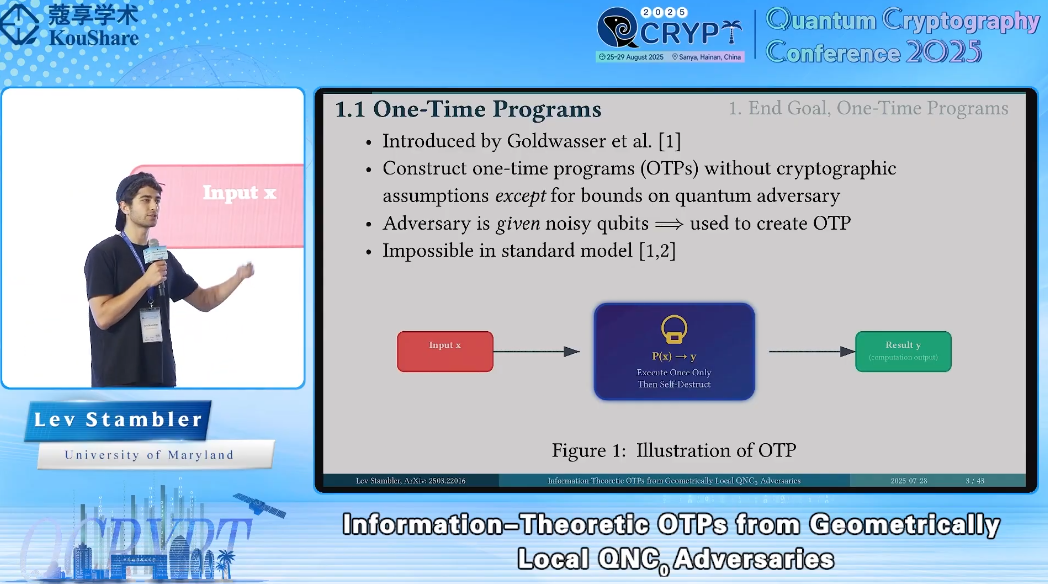NeverLocal at QCrypt 2025: The Frontier of Quantum Cryptography

QCrypt 2025 recently took place in Sanya, Hainan Province, China. QCrypt is the premier conference on quantum cryptography, focusing on the latest research and developments in the field. This year, the conference highlighted advancements in quantum internet, quantum key distribution (QKD), and new schemes using quantum resources (position verification, quantum money, one-time programs etc.).
One of my key takeaways: quantum internet infrastructure is rapidly advancing and is being deployed across the globe. Countries such as China, members of the EU, and Singapore are investing heavily in quantum networks, with several pilot projects already operational. Satellite-based QKD is also making significant strides, with new experiments demonstrating secure key distribution over thousands of kilometers.
Our presentation
I had the privilege of presenting our recent work on “Information Theoretic One-Time Programs from Geometrically Local QNC0 Adversaries” at the conference. In this talk, I discussed a core theme of my research: how we can leverage the physical limitations of quantum hardware—noise, locality, and an inability to be perfectly fault-tolerant—as a cryptographic resource.
Instead of relying on computational assumptions (which might be broken) or waiting for perfect, large-scale quantum computers, we show how to build powerful primitives like one-time memories (OTMs), and thus one-time programs, in an information-theoretic setting because the adversary is constrained by near-term, noisy hardware. It’s a bit of a paradigm shift: using the “bugs” (noise) as a “feature” (security).

Key Themes: Noise as a Feature, Not Just a Bug
This ties directly into my other main takeaway from the conference. There’s a massive amount of theory work pouring into how to optimize quantum internet protocols for real-world usage due to noise. While many are focused on error correction to fight the noise, my work—and a growing body of other research—is about using it.
Still, on the deployment front, we are seeing real-world QKD come online via trusted relays. This is the pragmatic, correct-in-my-view approach for now. While we all want true quantum repeaters, trusted nodes get us secure links over practical distances today. The EU and China aren’t waiting for perfect repeaters to build their networks, and that’s driving the field forward.
The Hunger for Applications Beyond QKD
The third, and perhaps most exciting, theme was the palpable hunger for applications beyond QKD. QKD is the “killer app,” but it’s fundamentally a key-exchange protocol. The community is clearly asking, “What else can we do with these new quantum resources?”
This is precisely where my work fits. People are finally looking seriously at primitives like quantum money, blind quantum computation, position verification, and (of course) one-time programs. These are functionalities that are impossible to achieve information-theoretically with classical resources.
Many attendees were excited to learn that an existing line of works show that we can build things like OTPs from simple, “BB84-like” single-qubit states—the exact kind of technology being deployed in QKD networks right now. It means we don’t have to wait for fault-tolerance to unlock the next wave of quantum cryptographic applications.
Wrapping Up
Overall, QCrypt 2025 made it clear that the quantum internet is moving out of pure theory. The first-generation hardware (QKD, trusted relays) is being deployed, and the theory community is bifurcating in a healthy way:
-
Engineering-focused theory to optimize protocols for this noisy, near-term hardware.
-
Cryptography-focused theory (my camp) asking what new, “impossible” functionalities we can build with this noisy, near-term hardware.
At NeverLocal, we are firmly in that second camp, building the infrastructure for a future where quantum mechanics provides fundamentally new cryptographic guarantees. Stay tuned.